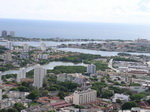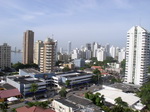Cartagena
Cartagena is a port town in northwestern Colombia. The city is named after the Spanish city of Cartagena and is also known as Cartagena de Indias. It is the capital of the department of Bolivar and has a population of 1,075,000 people.
History
 Cartagena in 2005
Cartagena in 2005
Excavations show that this area is since around 7000 years BC. inhabited. The Spanish explorers in early 16th century, made several attempts to found cities here. The first successful attempt was that of that of Pedro de Heredia. He founded Cartagena on June 1, 1533. The city has long been an important link between Spain and South America. During the sixteenth century and the seventeenth centuries, Cartagena was one of the major ports of the treasure fleet and therefore a popular target for buccaneers. Thus the city was plundered in 1585 by Francis Drake and in 1697 by the French Admiral Jean du Casse.
In March 1741 the city was attacked by troops of the British Admiral Edward Vernon, who were advancing to Cartagena with a squadron of 186 ships with 2,000 guns and a corps of over 6,000 Marines. But the attack was repulsed due to the strong resistance offered by General Blas the Lezo, his garrison and the population of the city. Vernon had to withdraw when the arrival of a relief army led by Colonel Engineer Carlos Suillars the Desnaux, made his position untenable.
Economy
Cartagena is both an important economic center, as well as a tourist attraction. The city has one of the major ports of the country. The city lies northeast of Panama, the Caribbean Sea and thus also on the Atlantic Ocean. The city has the largest Colombian Naval base in the Caribbean.
Cartagena Sights
One finds in the old colonial city many buildings including the Palace of the Inquisition, a cathedral, the Santa Clara Convention and a Jesuit school. Peter Claver, patron saint of slaves, worked in and from the school. The center is on the World Heritage List since 1980. Around the town are a number of defenses, including the castle of San Felipe de Barajas, built between 1536 and 1657, the city walls surrounding the Old City (las Murallas), and the forts of San Jose and San Fernando, built between 1751 and 1759 in BocaChica.
 Photo of Bocagrande
Photo of Bocagrande
Outside the city walls, you can find the statue of India Catalina, a local Indian hero. To the south lies the modern town, on the peninsula of Boca Grande.
Cartagena Surroundings
About thirty kilometers southwest of Cartagena are the Islas de Rosario (Rosario Islands), a protected national park with a large variety of tropical fish and sharks.
In the West Cartagena looks on the Caribbean Sea. South, the Bahía de Cartagena location, which has two entrances: BocaChica in the south BocaGrande and the north.